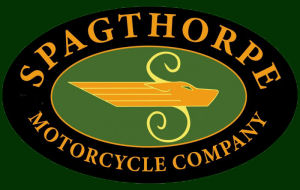The latest in the Spagthorpe Motorcycle Company's ground-breaking
series of dirt-sport bikes, the Bird Dog ushers in a new era of exciting
marketing and niche technology.
Borrowing heavily from its neighbors in the sport-bike and dirt-bike
markets, the Bird Dog displays features of both classes of motorcycle.
The engine displaces 1000cc, placing it squarely between the 600cc inline-four
sportbike class and the 1200cc boxer-win dirtbike class. Its configuration
is aY-3: a dual/single-opposed triple. This unique engine configuration
was an attempt to combines the smoothness of an V-four with the balance
of the opposed twin. Dual-opposed 250cc pistons travel in their bores
horizontally in lock-step with one another, perfectly balancing the 500cc
vertical single.
| |
These are the initial sketches for the air-cooled Bird-Dog engine.The 500cc piston operates vertically while the 250cc pistons
operate horzontally, all off a single-pin crankshaft. This engine has side-valves directly actuated by belt-driven camshafts. The
belts also drive a matched pair of alternators. The multiplate clutch is at the front, driving the transmission input shaft
through a chain. It is not clear from this drawing where the carburetors, exhaust, or oil pump woudl be mounted.
|
|
Smooth carburetion was a puzzle somewhat solved by Spagthorpe engineers.
Initial designs called for simplicity: two valves per piston and a single
carburetor to feed the lot.
An inidial design called for the twin pistons to share intake and exhaust
valves, but the resulting complexity of the cylinder head offset any cost
savings and the desired compression ratio could never be achieved.
A second proposal was once again with the standard two valves per cylinder
but with two carburetors, one on each side.
It was concluded that the smaller "twin" pistons would have two valves each, with the usua
splitting of duty between intake and exhaust. Meanwhile the larger "single" piston would have
four valves"”two intake and two exhaust. Each intake valve would be serviced by its own
carburetor, for four total. The exhaust system would be completed with a beautifully sculpted
four-into-two-with-a-wiggly-bit-into-one-into-two with a finely crafted arrangement of tuned
resonant chambers and negative-feedback and to eliminate parasitic oscillations and smooth out
any unevennessess in the torque curve.
Speedy windup and plenty of compression braking are achieved through Spagthorpe's revolutionary radial-rotational reservoirs, the
much-heralded Spagthorpe Active Flywheel design. On the flywheel are mounted nine radially mounted rods which carry weights and springs.
The springs exert inward force on the weights so that at rest the weights are close to the rotation axis, minimzing the flywheel's polar
moment of inertia for quick acceleration. As the engine speeds up, the weighs are expelled outward, increasing the inertia for smooth
running.
High-Performance accessories include variable-rate springs and cartridge-damper emulators for the flywheel weights.
Alternatively, the simpler two-carburetor model proposal with a passive flywheel is being considered as an economy alternative to the
high-tech version.

